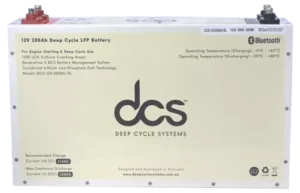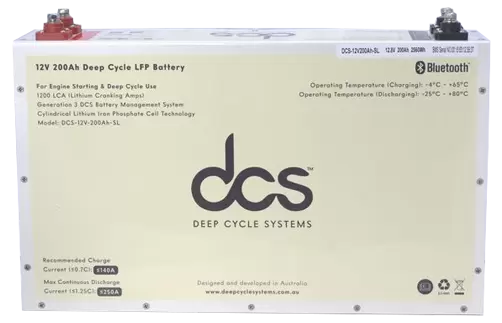Are you looking to upgrade your 4WD’s performance? Look no further than a lithium cranking battery. These advanced batteries are revolutionizing the automotive industry with superior power, longevity, and reliability. This blog post will explore everything you need to know about lithium-ion cranking batteries and how they can take your 4WD to the next level.
Understanding the Basics of Lithium-Ion Cranking Batteries
Lithium-ion cranking batteries represent a significant advancement in automotive battery technology. These batteries function by moving lithium ions between the anode and cathode, which in turn generates electrical power. Their remarkable energy density sets them apart; this allows them to store more energy in a smaller, lighter package compared to traditional batteries. This attribute is particularly beneficial for 4WD vehicles, where every ounce of weight and every inch of space matter.
These batteries boast impressive longevity, often outlasting their lead-acid counterparts by several years. This durability stems from their ability to withstand numerous charge and discharge cycles without significant degradation. Another key advantage is their efficiency in charging. Lithium-ion cranking batteries can recharge much faster, meaning less downtime and more adventure in your 4WD.
Lithium-ion batteries are virtually maintenance-free, unlike the older lead-acid batteries that necessitate regular maintenance to ensure peak performance. This aspect is especially advantageous for 4WD enthusiasts who prefer spending time exploring rather than maintaining their vehicle’s components. Designed to deliver a consistent and reliable power supply, these batteries can endure the demanding starts and stops typical in off-roading conditions, ensuring your vehicle performs optimally when it matters most.
Why Your 4WD Needs a Lithium-Ion Cranking Battery
For the off-road enthusiast, power and reliability aren’t just preferences but necessities. A lithium-ion cranking battery becomes an essential upgrade for your 4WD for many reasons, primarily because of the robust burst of energy it delivers right when you need it. Picture yourself gearing up for an early morning trail ride or preparing to tackle a steep, rocky incline; the last thing you want is your vehicle struggling to start due to an insufficient power source. Lithium-ion batteries ensure that your 4WD roars to life with the first turn of the key, no matter the external conditions.
Beyond the instant power delivery, these batteries significantly contribute to the overall weight reduction of your vehicle. In off-roading, where every pound can impact performance, the lightweight nature of lithium-ion batteries compared to their lead-acid counterparts can make a noticeable difference in handling and fuel efficiency. Furthermore, the reliability factor must be balanced.
With their superior charge retention and ability to handle the rigorous demands of frequent starts, lithium-ion cranking batteries reduce the likelihood of you finding yourself stranded in remote locations due to battery failure. These advantages outline why integrating a lithium-ion cranking battery into your 4WD setup is not just an upgrade—it’s a transformation. It’s about ensuring your vehicle is as prepared and capable as you are when facing the unpredictable challenges of off-roading.
Installation Tips for Lithium Cranking Batteries in 4WDs
When incorporating lithium cranking batteries into your 4WD, there are critical steps to ensure a safe and efficient setup. It’s crucial to have a secure mounting system. Since off-road terrain can be rough and unpredictable, the battery must be anchored firmly to prevent shifting that could lead to disconnections or damage. Use high-quality battery mounts and brackets designed for the rigours of off-roading. Focus on the electrical connections. These should be tight, clean, and free of corrosion to maintain optimal conductivity.
A dielectric grease can help protect these connections from moisture and dirt, which are inevitable in off-road conditions. If your 4WD was initially equipped with a lead-acid battery, you might need to adjust the charging system to accommodate the specific needs of a lithium-ion battery. This often involves consulting with a professional or referring to the battery manufacturer’s guidelines to ensure Compatibility and prevent overcharging.
Inspecting the existing wiring and components for wear or damage before installation is wise. Upgrading to a lithium-ion battery may expose weak points in the vehicle’s electrical system that were not apparent with a less powerful battery. Replacing or upgrading worn parts can prevent issues after the installation. Remember, while the installation process is generally straightforward, the specifics vary widely between 4WD models and battery types. Refer to the manufacturer’s installation instructions or consult a professional to avoid common pitfalls and ensure your lithium-ion battery performs to its full potential in your 4WD.
Comparing Lithium-Ion and Lead-Acid Batteries for 4WDs
The debate between lithium-ion and lead-acid batteries is pivotal for 4WD owners making a crucial choice for their vehicle’s power source. Lead-acid batteries have been the traditional choice for decades, and they are known for their affordability and widespread availability. However, lithium-ion cranking batteries are setting a new standard with features that greatly surpass those of lead-acid batteries, particularly in efficiency, weight, and longevity. One of the primary considerations is the weight difference. Lithium-ion batteries are significantly lighter than lead-acid batteries, which can lead to improved fuel efficiency and vehicle handling, which is especially critical in off-roading scenarios where every pound matters.
This weight reduction does not come at the expense of power; lithium-ion batteries are known for their high energy density, providing more cranking power to start your 4WD efficiently. Durability is another factor where lithium-ion batteries excel. They can endure more charge-discharge cycles than lead-acid batteries, which translates into a longer service life. This durability makes them a more cost-effective option despite their higher initial purchase price.
Efficiency also sets lithium-ion batteries apart. They exhibit minimal energy loss during charge and discharge cycles, ensuring that almost all the energy stored is available. This efficiency contributes to their rapid charging capabilities, allowing 4WD owners to get back on the road faster. While the upfront cost of lithium-ion cranking batteries may be higher than that of lead-acid batteries, the long-term benefits—such as extended lifespan, reduced weight, and improved performance—make them a worthwhile investment for severe off-roaders and those prioritizing vehicle efficiency and reliability.
Maximizing the Life of Your Lithium-Ion Cranking Battery
Several proactive measures should be taken to extend the service life of your lithium-ion cranking battery. Maintaining a consistent charge is crucial; avoiding allowing the battery to drain completely is advisable. Lithium-ion batteries thrive on partial discharges followed by recharges rather than being run down to zero before charging. Implementing a regular charging routine can significantly contribute to the battery’s longevity. Storage conditions also play a vital role in preserving battery life. When not in use, ensure your lithium-ion battery is kept in an environment that is neither too hot nor too cold.
Extreme temperatures can adversely affect the battery’s chemistry and shorten lifespan. Ideally, an excellent, dry location is best for storage. It’s essential to monitor the battery’s health by checking its charge level periodically.
This can help identify any potential issues before they become serious. If the battery will not be used for an extended period, storing it with a charge level of around 50% is recommended to maintain optimal health. Ensuring the battery firmware is up to date can also help maximize its life. Manufacturers may release updates that improve battery management and efficiency. Keeping your battery’s software current can enhance its performance and durability, ensuring it provides reliable power to your 4WD for years.
Choosing the Right Lithium Cranking Battery for 4WD
Choosing the right lithium cranking battery for 4WD involves carefully considering these factors to ensure it meets your specific needs and enhances your 4WD’s performance and reliability.
Assess your 4WD’s Requirements
Start by understanding your vehicle’s power needs. Consider the engine size, electrical accessories, and typical usage conditions. This will guide you in selecting a battery with the appropriate capacity and power output.
Check Compatibility
Ensure the lithium-ion cranking battery you’re considering is compatible with your 4WD’s make and model. Compatibility extends to physical dimensions for proper fitment and electrical requirements for seamless integration.
Evaluate Energy Density and Weight
One of the significant advantages of lithium-ion batteries is their high energy density. Choose a battery that substantially reduces weight without compromising on cranking power, which is vital for enhancing performance and fuel efficiency in off-road conditions.
Consider the Battery’s Lifespan and Warranty
Look for lithium-ion cranking batteries with a proven longevity and reliability track record. A longer lifespan and a solid warranty can indicate quality and offer peace of mind, making it a more cost-effective choice in the long run.
Check Charging Speed and Efficiency
Since off-roading often involves varying power demands, opt for a battery that charges quickly and efficiently. This ensures your 4WD is ready to go when you are, reducing downtime on your adventures.
Maintaining Your Lithium-Ion Cranking Battery for Peak Performance
Regular checks and cleanings are essential to maintain your lithium-ion cranking battery in optimal condition. Ensure the battery’s surface and terminals are clear of dust, dirt, or grime to prevent damage. Regularly inspect the connections for tightness and look for any signs of corrosion, addressing any issues immediately to maintain efficient conductivity. It’s also beneficial to periodically verify the battery’s voltage and charge levels.
This practice aids in the early detection of discrepancies that could indicate a problem. Ensure the area around the battery is well-ventilated to facilitate proper heat dissipation during operation. Taking these steps not only supports the battery’s health but also upholds the overall performance of your 4WD’s electrical system. Remember, while lithium-ion batteries are renowned for their low maintenance, attentiveness to these aspects ensures you get the most out of your investment, preserving the battery’s peak performance over time.
Conclusion
Embarking on enhancing your 4WD with a lithium cranking battery marks a pivotal shift towards unlocking unmatched vehicular capability and endurance. These batteries elevate the driving experience through their exceptional power delivery and efficiency and stand as a testament to the innovative strides in automotive technology. By prioritizing proper installation and adhering to maintenance guidelines, owners can ensure that their investment enhances their vehicle’s performance and contributes to a sustainable and efficient operation. They are embracing the shift to lithium-ion technology, positioning 4WD enthusiasts at the forefront of a movement that values power, performance, and longevity in equal measure.
FAQs
Q: Will a lithium-ion cranking battery still function appropriately in extremely hot or cold conditions?
A: Absolutely. These batteries are engineered to deliver reliable performance across a broad temperature spectrum. While they excel in various climate conditions, adhering to the manufacturer’s guidelines for use and storage can enhance their efficiency and longevity in extreme temperatures.
Q: What safety measures exist for using lithium-ion cranking batteries in 4WDs?
A: Lithium-ion cranking batteries are built with several safety mechanisms to safeguard against everyday hazards such as overcharging and overheating. It’s crucial, however, to ensure proper installation and routine checks to benefit fully from these safety features. Many models’ integrated battery management systems (BMS) further enhance their safety by closely monitoring the battery’s operational parameters.
Q: How can I maximize the lifespan of my lithium cranking battery?
A: Consistent care and maintenance is critical lithium cranking battery. Avoid fully depleting the battery and instead maintain a regular charging schedule. Storage in a temperature-controlled environment and periodic checks for cleanliness and connection integrity can also significantly extend the battery’s usable life. Implementing these practices will help maintain the battery’s health and efficiency over time.
Q: Can updating the battery’s firmware improve its performance?
A: Yes, manufacturers may release firmware updates designed to optimize the battery’s performance and efficiency. Keeping the battery’s firmware updated can ensure you’re utilizing the latest advancements in battery technology, enhancing both performance and durability.
| Other Good Articles to Read |
| Blogs Rain |
| Cme Blog Spot |
| Garcias Blogs |
| Yyc Blogs |
| Blogs-Hunt |
| Impact-Blog |
| Smarty Blogs |
| Ed Blog |
| Mo Blogs |
| Blogs Em |
| Blogs T |
| Related Business Listings |
| Contact Directory |
| Local Business Profiles |
